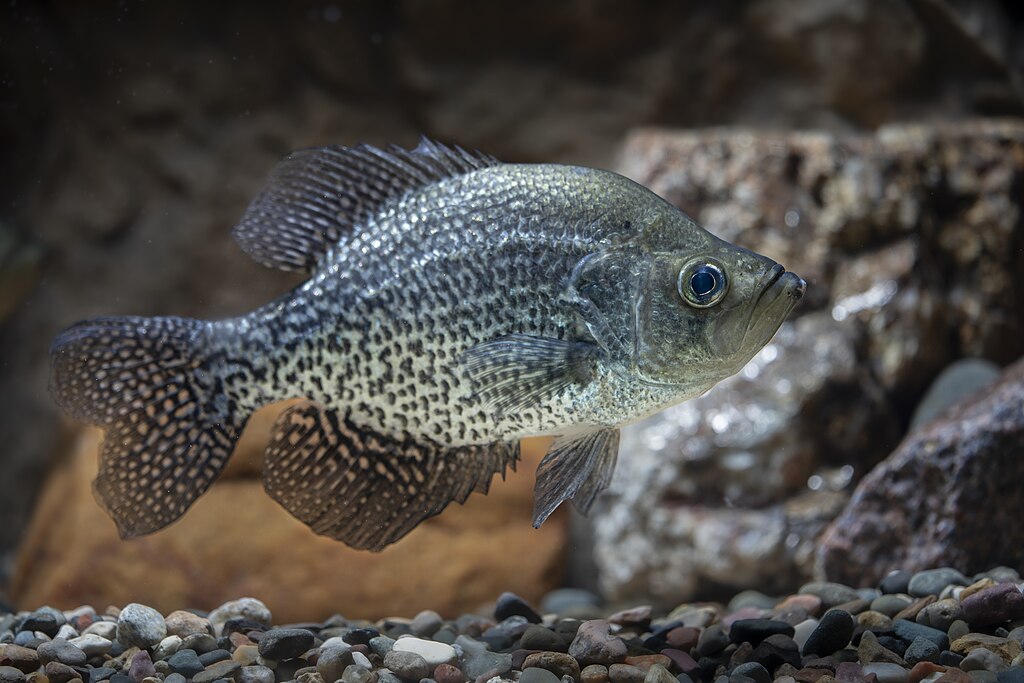
Crappie
Scientific Name: Pomoxis spp.
Also known as: Black Crappie, White Crappie, Calico Bass, Papermouth, Speckled Perch
General Description
Crappie are popular freshwater fish known for their delicate flavor and aggressive fighting ability when caught. There are two main species of crappie: the black crappie (Pomoxis nigromaculatus) and the white crappie (Pomoxis annularis), both of which are highly sought after by anglers. Black crappie are characterized by a dark, olive-green body with a pattern of irregular black spots, while white crappie tend to have a lighter body color with more vertical bars running across their sides. Both species are relatively small fish, with average adult sizes ranging from 8 to 12 inches, though trophy-sized crappie can grow up to 16 inches or more.
Crappie are known for their schooling behavior, especially during the spawning season when large groups gather in shallow waters. These fish have a slender, elongated body and are prized for their soft, flaky white meat. They are aggressive predators, feeding primarily on smaller fish, invertebrates, and occasionally aquatic insects. Crappie are also a favorite target for anglers due to their abundance, accessibility, and the challenge they present when fishing in schools.
These fish can be found in various freshwater habitats, including lakes, ponds, rivers, and reservoirs, and are a popular catch in both recreational and tournament fishing.
Where to Find Them
Crappie are widely distributed across North America, with both black and white crappie found in most states. They inhabit a variety of freshwater environments, including rivers, lakes, and reservoirs, where they prefer shallow, warm waters with plenty of cover, such as submerged vegetation, fallen trees, or rocky structures. They are often found near the edges of weed beds, submerged rocks, or drop-offs, especially during the spring and fall months when the water temperatures are optimal for feeding and spawning.
In the spring, crappie move into shallow waters to spawn, typically near the shoreline or in areas with abundant cover. During this time, they can be found in large schools, which makes them easier to target. After the spawn, they often return to deeper waters, particularly in reservoirs or lakes, where they continue to school and feed on small baitfish. During the summer months, crappie are generally located in deeper, cooler waters, but they still tend to congregate around structures like submerged trees, fallen logs, and deeper weed beds.
In rivers, crappie can be found near pools, eddies, and slack-water areas where the current is slower. The best time to fish for crappie is during their active feeding periods, which occur early in the morning or late in the afternoon, especially in the warmer months.
Best Baits
Live Bait Options
- Minnows
- Small shad
- Worms (nightcrawlers or red worms)
- Crickets
- Small sunfish
Artificial Bait Options
- Soft plastic jigs (1/32 to 1/8 oz)
- Crappie tubes
- Small spinnerbaits
- Crankbaits (small, diving)
- Inline spinners
- Small swimbaits
Best Fishing Methods
Fishing for crappie requires patience and a careful approach. These fish are often found in schools, so once you locate a group, you can catch multiple fish in a short period. The most effective way to fish for crappie is by using light tackle and fishing near cover or structure where they tend to gather.
For live bait, minnows are by far the most popular and effective option for catching crappie. A simple hook-and-sinker rig, a float, or a slip-bobber rig can be used to keep the bait at the right depth. Crappie prefer to feed just above the bottom or near submerged objects, so adjusting the depth of your live bait accordingly is important.
When using artificial lures, soft plastic jigs or crappie tubes work exceptionally well, especially in small sizes. These lures can be fished vertically (dropped straight down into the water) or casted and slowly retrieved. Crappie are often attracted to small, slow-moving baits, so a slow, steady retrieve is key when using jigs or crankbaits.
Fishing during the early morning or late afternoon is ideal, as crappie tend to be most active during these periods. They are also more likely to be closer to shore or in shallower water when feeding, which makes these times optimal for targeting them. For boat anglers, trolling with small jigs or crankbaits at slow speeds is another effective method for covering large areas and locating schools of crappie.
Summary
Fishing for crappie is a rewarding experience for anglers of all skill levels, whether you’re fishing from the bank, a boat, or a dock. These fish are abundant and widely distributed across North America, making them a prime target for recreational fishing. Crappie are known for their schooling behavior, especially during the spawning season, which can make it easier to catch multiple fish in a single trip.
The best time to fish for crappie is in the spring and fall, when they are more active and can be found in shallower waters near structures. During the warmer summer months, crappie move to deeper waters but can still be found around submerged structures like fallen trees or deep weed beds. They are aggressive feeders, so using live bait like minnows or small shad, or artificial baits like jigs and small crankbaits, will often result in a successful day of fishing.
For the best results, it’s important to fish during the early morning or late afternoon hours when crappie are most active. Whether you’re fishing from shore or trolling from a boat, crappie fishing is an enjoyable and accessible pursuit for anglers looking to reel in a delicious catch.
Related
Catch More Slabs: Spring Crappie Fishing Secrets
Spring is an exciting time for anglers — and few fish get the heart racing…
Catching Fall Crappie: Simple Tips for a Successful Fishing Trip
Fall is one of the best times to catch crappie. As the weather cools and…
Top Lures for Fall Slab Crappie
Fall is one of the best times of the year to catch slab crappie, those…





